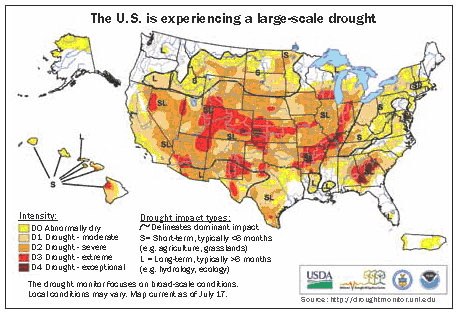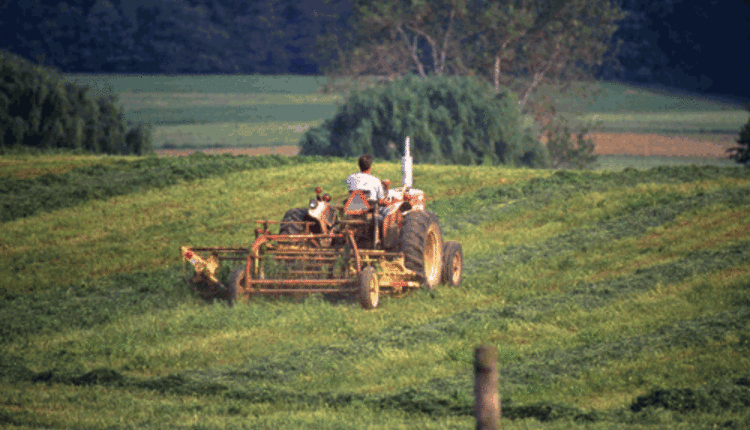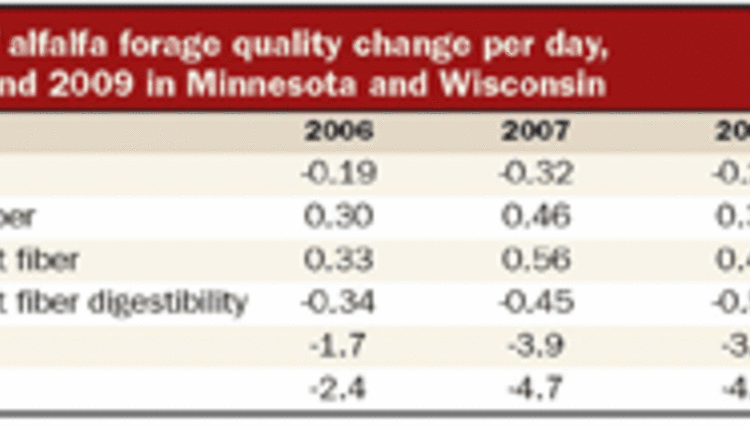The author is an extension forage agronomist, University of Wisconsin-Madison.
More than 60 percent of the United States has been affected by drought. In many of these water-deprived states, forage is needed for dairy herds. Good management of moisture-stressed forages can optimize production under dry conditions and will enhance forage stand quality and life.

Alfalfa and other legumes respond similarly, though alfalfa will be one of the most drought tolerant in the group. Moisture stress in the first 14 days after a harvest reduces the number of basal buds and the number of stems per plant, as well. These first two weeks of drought stress have the greatest effect on yield. Even if rain occurs later in the growth period, yield will be greatly diminished.
Cell enlargement is inhibited during a drought. This is the reason that stem internode length is reduced; thus, the plant is stunted and flowering occurs at reduced plant height. Leaf size and leaf growth rate are reduced, although to a lesser degree than stem growth. Therefore, leaf percentage goes up under moisture stress.
The higher leaf ratio means that NDF generally drops, though effect varies with severity and timing of moisture stress. Stem nitrogen percentage moves upward while leaf nitrogen percentage drops, therefore whole plant nitrogen (CP) may be reduced, though effect varies with severity/timing of moisture stress.
Thus, drought tends to give reduced tonnage of forage that is higher in quality and we often see milk production improve in dairy herds.
What can be done
The recommendations for managing drought-stress alfalfa are:
1. If stand is over 10 inches tall and flowering, harvest if it is economic to do so.
2. If stand is 10 inches or less tall and flowering, do not cut. Let regrowth come through existing growth. Mowing will not enhance regrowth but adds labor and fuel costs and increases wheel traffic damage.
3. Make sure that soil fertility is at optimum levels. The alfalfa will not regrow and yield as well when it rains if a nutrient is deficient.
4. Scout and control potato leaf hopper, army worm and other insects. These insects can damage young shoots that would provide yield when moisture stress is reduced.
5. Drought-stressed new seedings should not be harvested during the season but may be harvested in late August if adequate growth is present to harvest. A late-fall cutting may also be taken. The key is to time harvests so that alfalfa either has no regrowth or more than 8 inches of regrowth at frost.
Moisture stress affects grasses similarly to alfalfa except that, if stems are present, forage quality of grasses may be lowered by stress rather than improved. Most grassy fields and pastures are stunted but are leafy and have few stems. Recommendations are:
Tasseling is a barometer
Many cornfields are stunted, some have significant firing. However, further growth will occur if moisture stress is relieved prior to tasseling. Further, plants are too wet to ensile and will have nitrate toxicity if yield is greatly reduced.
To preserve the greatest amount of high-quality forage, take the following steps:
1. Wait until tasseling to make a decision on whether to chop. Quality will be high but moisture may be too high for good ensiling. If moisture is above 70 percent, consider putting in a silo bag or baling and wrapping to reduce seepage losses.
2. If making silage or grazing, consider potential for nitrate toxicity. This is especially likely to be a problem if growth was reduced to less than 50 percent of normal and/or high levels of nitrogen were applied as fertilizer. Samples taken for nitrate tests must be frozen or analyzed immediately as nitrates will decline in tissue three to four hours after cutting. If above toxic levels, feed hay or some other forage in the morning and feed a small amount of corn silage or graze corn a couple hours in the afternoon.
What are some alternatives?
Late-summer seedings can supplement forage production following wheat harvest or early corn harvest. Consider planting sorghum-sudangrass, sudangrass or millet if you can expect at least eight weeks of above 80° temperatures. These grasses produce good tonnage under high temperatures but are warm season grasses and do not produce much tonnage when temperatures are cool.
If planting sorghum-sudangrass or sudangrass, we recommend a brown midrib type because quality is higher, yield drag is minimal compared to standard lines and standability is good through harvest. These forages should generally be harvested at about 32 inches for dairy quality forage or 36 inches for heifers and steers.
For most of the northern states, the best option is to wait until after August 1, and then consider planting oats with or without peas.
Oats, planted the first week of August can be expected to produce 2.5 to 3 tons per acre dry matter in an average year. Other small grains will generally produce about half as much since they do not put out a stem. Adding 20 pounds per acre of peas to the oats will enhance palatability but will not affect yield.
Wayne Coblentz from the USDA Dairy Forage Research Center found that a late-maturing forage cultivar (ForagePlus) produced maximum annual yields because the forage cultivar matured slowly and was better able to respond to sometimes erratic late-summer precipitation. Forage types mature later and produce more tonnage of quality forage. If seed from a forage type is not available, plant a late-maturing oat variety. If planting after the first week of August, a forage-type oat will provide less advantage and grain-type cultivars may be a better choice.
The fall-planted oat is higher in forage quality than spring-planted oats. Research at the University of Wisconsin by Ken Albrecht found that maturation of summer-sown (August) oats was delayed, resulting in 10 to 15 percent less neutral detergent fiber (NDF), 18 percent greater digestibility and 250 percent more water-soluble carbohydrate than spring-sown oat.
The recommendation would be to plant 1.5 to 2 bushels of oats per acre (with or without peas). Soil test to determine if sufficient residual nitrogen remains for the oat crop following the drought-reduced corn crop. If not, fertilize with 60 to 70 pounds of nitrogen per acre at planting. It is also important to check for any herbicide plant-back restrictions prior to planting. Planting should occur during the first week of August as earlier planting will result in earlier maturation and reduced yield.
If oat seed is unavailable use another spring small grain, though yield will be less. The order of choice should be triticale, rye and barley, based on yield. Ryegrass would also be a choice if adequate moisture is present, since it is more affected by drought stress.
The article appears on page 500 of the August 10, 2012 issue of Hoard's Dairyman.
More than 60 percent of the United States has been affected by drought. In many of these water-deprived states, forage is needed for dairy herds. Good management of moisture-stressed forages can optimize production under dry conditions and will enhance forage stand quality and life.

Alfalfa and other legumes respond similarly, though alfalfa will be one of the most drought tolerant in the group. Moisture stress in the first 14 days after a harvest reduces the number of basal buds and the number of stems per plant, as well. These first two weeks of drought stress have the greatest effect on yield. Even if rain occurs later in the growth period, yield will be greatly diminished.
Cell enlargement is inhibited during a drought. This is the reason that stem internode length is reduced; thus, the plant is stunted and flowering occurs at reduced plant height. Leaf size and leaf growth rate are reduced, although to a lesser degree than stem growth. Therefore, leaf percentage goes up under moisture stress.
The higher leaf ratio means that NDF generally drops, though effect varies with severity and timing of moisture stress. Stem nitrogen percentage moves upward while leaf nitrogen percentage drops, therefore whole plant nitrogen (CP) may be reduced, though effect varies with severity/timing of moisture stress.
Thus, drought tends to give reduced tonnage of forage that is higher in quality and we often see milk production improve in dairy herds.
What can be done
The recommendations for managing drought-stress alfalfa are:
1. If stand is over 10 inches tall and flowering, harvest if it is economic to do so.
a. Since quality is not declining as rapidly with advancing maturity in drought-stressed alfalfa, let the plants approach 100 percent bloom before harvest to allow the plant to build nonstructural carbohydrate reserves. In a perfect world, we would want to cut just before a rain so that regrowth can take full advantage of the moisture, but weather is difficult to predict.
b. Moisture-stressed alfalfa should be mowed at the normal cutting height. There is no advantage to raising the cutting height as it will simply reduce harvested yield. Alfalfa regrowth from axillary buds higher up on the stubble are smaller and produce less yield than stems growing from the crown buds.
2. If stand is 10 inches or less tall and flowering, do not cut. Let regrowth come through existing growth. Mowing will not enhance regrowth but adds labor and fuel costs and increases wheel traffic damage.
3. Make sure that soil fertility is at optimum levels. The alfalfa will not regrow and yield as well when it rains if a nutrient is deficient.
4. Scout and control potato leaf hopper, army worm and other insects. These insects can damage young shoots that would provide yield when moisture stress is reduced.
5. Drought-stressed new seedings should not be harvested during the season but may be harvested in late August if adequate growth is present to harvest. A late-fall cutting may also be taken. The key is to time harvests so that alfalfa either has no regrowth or more than 8 inches of regrowth at frost.
Moisture stress affects grasses similarly to alfalfa except that, if stems are present, forage quality of grasses may be lowered by stress rather than improved. Most grassy fields and pastures are stunted but are leafy and have few stems. Recommendations are:
1. Harvest or graze if tonnage justifies and/or height is over 8 to 10 inches. Leaves that have turned yellow will not grow and should be removed to make way for new leaf growth.
2. Apply 40 pounds per acre of nitrogen to stimulate fall growth if rain occurs before mid-August. This cannot be manure since nutrients will become available too slowly to provide optimum fall growth.
Tasseling is a barometer
Many cornfields are stunted, some have significant firing. However, further growth will occur if moisture stress is relieved prior to tasseling. Further, plants are too wet to ensile and will have nitrate toxicity if yield is greatly reduced.
To preserve the greatest amount of high-quality forage, take the following steps:
1. Wait until tasseling to make a decision on whether to chop. Quality will be high but moisture may be too high for good ensiling. If moisture is above 70 percent, consider putting in a silo bag or baling and wrapping to reduce seepage losses.
2. If making silage or grazing, consider potential for nitrate toxicity. This is especially likely to be a problem if growth was reduced to less than 50 percent of normal and/or high levels of nitrogen were applied as fertilizer. Samples taken for nitrate tests must be frozen or analyzed immediately as nitrates will decline in tissue three to four hours after cutting. If above toxic levels, feed hay or some other forage in the morning and feed a small amount of corn silage or graze corn a couple hours in the afternoon.
What are some alternatives?
Late-summer seedings can supplement forage production following wheat harvest or early corn harvest. Consider planting sorghum-sudangrass, sudangrass or millet if you can expect at least eight weeks of above 80° temperatures. These grasses produce good tonnage under high temperatures but are warm season grasses and do not produce much tonnage when temperatures are cool.
If planting sorghum-sudangrass or sudangrass, we recommend a brown midrib type because quality is higher, yield drag is minimal compared to standard lines and standability is good through harvest. These forages should generally be harvested at about 32 inches for dairy quality forage or 36 inches for heifers and steers.
For most of the northern states, the best option is to wait until after August 1, and then consider planting oats with or without peas.
Oats, planted the first week of August can be expected to produce 2.5 to 3 tons per acre dry matter in an average year. Other small grains will generally produce about half as much since they do not put out a stem. Adding 20 pounds per acre of peas to the oats will enhance palatability but will not affect yield.
Wayne Coblentz from the USDA Dairy Forage Research Center found that a late-maturing forage cultivar (ForagePlus) produced maximum annual yields because the forage cultivar matured slowly and was better able to respond to sometimes erratic late-summer precipitation. Forage types mature later and produce more tonnage of quality forage. If seed from a forage type is not available, plant a late-maturing oat variety. If planting after the first week of August, a forage-type oat will provide less advantage and grain-type cultivars may be a better choice.
The fall-planted oat is higher in forage quality than spring-planted oats. Research at the University of Wisconsin by Ken Albrecht found that maturation of summer-sown (August) oats was delayed, resulting in 10 to 15 percent less neutral detergent fiber (NDF), 18 percent greater digestibility and 250 percent more water-soluble carbohydrate than spring-sown oat.
The recommendation would be to plant 1.5 to 2 bushels of oats per acre (with or without peas). Soil test to determine if sufficient residual nitrogen remains for the oat crop following the drought-reduced corn crop. If not, fertilize with 60 to 70 pounds of nitrogen per acre at planting. It is also important to check for any herbicide plant-back restrictions prior to planting. Planting should occur during the first week of August as earlier planting will result in earlier maturation and reduced yield.
If oat seed is unavailable use another spring small grain, though yield will be less. The order of choice should be triticale, rye and barley, based on yield. Ryegrass would also be a choice if adequate moisture is present, since it is more affected by drought stress.











